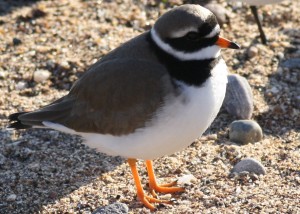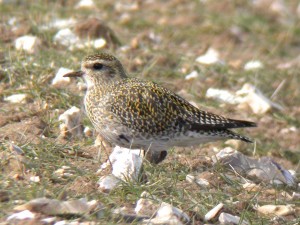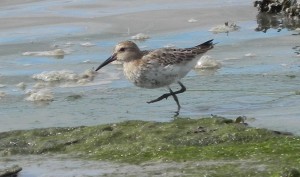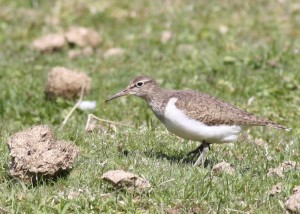Wader varieties at Montrose Basin – part 2
The waders we’ll be looking at this week are some of the smallest species you find at Montrose and are often seen at the tide line along with the redshanks.
Ringed plovers.

The Dick Turpin’s of the wader word (in appearance rather than behaviour), the ringed plovers are most easily identified by the black band across their eyes and around their throats. Males keep the black on their foreheads all year round, while it is lost in females over the winter. Otherwise, these birds are classified as being small, dumpy and short legged, with brown/grey plumage on top and a white chest and belly. The legs and bills of adults are orange (with a black tip at the end of the bill), but the juveniles you’ll see around this time of year have a black bill and dull, yellow legs. They also tend to be a little slimmer, and have no black on the throat, around the eyes or on the forehead. Instead these tend to be a brown colour.
Behaviour wise, you’ll often see their distinctive dash and stop approach to food hunting, and it’s this sudden run that will give them away in this brown and grey habitat.
Golden plover.

Though in the same family as the ringed plover, golden plover’s are more similar in size to redshank and are commonly found in the surrounding fields rather than on the Basin itself. They are short billed, with a round head and distinctive yellow (golden/brown from a distance) and black plumage. The legs and bill are also black. During the breeding season the adults tend to have a black face, throat and chest, but this disappears over winter with the face and chest becoming a yellow/ brown colour, and the belly white. Juveniles’ are very similar in appearance to adults at this time of year.
Golden plovers tend to congregate in large numbers over the winter months and are usually seen alongside lapwings. When feeding you’ll often see them follow a run and tile motion while hunting for worms and beetles.
Dunlin.

This is perhaps the most complicated wader to identify around this time of year when they are in transitional and winter plumage. A small wader with short legs but medium length curved bill, their most distinctive feature is their ‘hunch backed’ appearance. During the breeding period they can be identified by their distinctive black belly, but in winter this is lost to white and the plumage on the top turns from a rich chestnut colour to a pale, brown/grey colour with dark streaks at the shaft. During autumn you’ll see a mixture of the chestnut and brown/grey feathers throughout the wings, with juveniles being distinguishable by black and cream feathers mixed in with the chestnut and blotches found across the chest and belly. You’ll also notice a change in the plumage found across the face, changing from a pale colour with specks of black in summer, to a pale chestnut during autumn, and the same brown/grey found throughout the body.
Usually seen in large numbers, they can be found scurrying around at low tide under the redshank.
Common sandpiper.

Probably the easiest way to identify this species is by its behaviour rather than appearance as its rear can be seen doing a rhythmic up and down bobbing action. The body is usually carried in a horizontal, semi-crouched manner, with the neck being shorter and the tail longer than most waders. The leg colour has been described as being a blue/grey or greenish or brownish or yellow/grey, but the top plumage is an olive/brown colour and the belly is always a bright white. Dark arrow shaped markings can be seen on each feather of the adult, but this becomes less obvious during winter. The juveniles are actually more distinctive; with streaks being seen on the side of the breast, pale borders around each wing feather, and barred wing coverts (which are the smaller feathers found at the base of the flight feathers). Common sandpipers tend to be found in more freshwater, estuarine habitats than right on the very coast. At Montrose this would be at the mouth of the South Esk river, just up from the Old Montrose Pier.
Green sandpiper.
A little larger than the common sandpiper, this species is very shy and will usually only be noticed if it’s been disturbed when it will fly off in a zigzagged flight pattern. It has the same distinctive walk as its common cousins and is also seen as having a short neck and long tail. However, green sandpipers have very dark brown (almost black in appearance) upper body, chest and head plumage, with a pale belly and white rump. While during the breeding season the chest plumage is lighter and more mottled than the wings, they become almost uniform during the winter months. The legs and long bill are a dark, green colour, and a white line can be seen from the bill to the eyes. There is also a white ring around the eye, but this isn’t always obvious from a distance. The juveniles are very similar to the adults throughout the year, and are only distinguishable by the buff spots found along the belly.
Next week we’ll be looking at the knots, turnstones, whimbrels, and black-tailed and bar-tailed godwits.
Of course, no blog this time of year would be complete without an up-date on the pink-footed geese numbers, which are now 40,000 and rising.
Georgina Bowie (Visitor Centre Assistant)
Help protect Scotland’s wildlife
Our work to save Scotland’s wildlife is made possible thanks to the generosity of our members and supporters.
Join today from just £3 a month to help protect the species you love.
Preface
The waders we’ll be looking at this week are some of the smallest species you find at Montrose and are often seen at the tide line along with the redshanks. …
